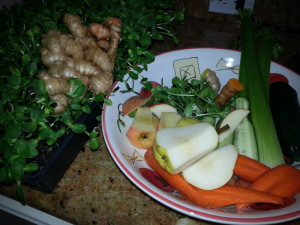 Turmeric has been a main spice ingredient in Indian food and I may have purchased the orange colored spice once in my life and left it in the spice cabinet for years where it hardened and I threw it in the trash. To tell you the truth I never knew what to do with it. But now that I am reaching Master Juicer title (self named) I have been researching the different herbs and vegetables to super-size my juice recipes turning me and my followers into SUPER HUMANS!!! Da da da TA! So here is what I found out about turmeric.
Turmeric has been a main spice ingredient in Indian food and I may have purchased the orange colored spice once in my life and left it in the spice cabinet for years where it hardened and I threw it in the trash. To tell you the truth I never knew what to do with it. But now that I am reaching Master Juicer title (self named) I have been researching the different herbs and vegetables to super-size my juice recipes turning me and my followers into SUPER HUMANS!!! Da da da TA! So here is what I found out about turmeric.
Turmeric has a peppery, warm and bitter flavor and a mild fragrance slightly reminiscent of orange and ginger, and while it is best known as one of the ingredients used to make curry, it also gives ballpark mustard its bright yellow color.
A Potent, Yet Safe Anti-Inflammatory
The volatile oil fraction of turmeric has demonstrated significant anti-inflammatory activity in a variety of experimental models. Even more potent than its volatile oil is the yellow or orange pigment of turmeric, which is called curcumin. Curcumin is thought to be the primary pharmacological agent in turmeric. In numerous studies, curcumin’s anti-inflammatory effects have been shown to be comparable to the potent drugs hydrocortisone and phenylbutazone as well as over-the-counter anti-inflammatory agents such as Motrin. Unlike the drugs, which are associated with significant toxic effects (ulcer formation, decreased white blood cell count, intestinal bleeding), curcumin produces no toxicity.
“Curcumin may provide an inexpensive, well-tolerated, and effective treatment for inflammatory bowel disease (IBD) such as Crohn’s and ulcerative colitis, recent research suggests.”
Relief for Rheumatoid Arthritis
Clinical studies have substantiated that curcumin also exerts very powerful antioxidant effects. As an antioxidant, curcumin is able to neutralize free radicals, chemicals that can travel through the body and cause great amounts of damage to healthy cells and cell membranes. This is important in many diseases, such as arthritis, where free radicals are responsible for the painful joint inflammation and eventual damage to the joints. Turmeric’s combination of antioxidant and anti-inflammatory effects explains why many people with joint disease find relief when they use the spice regularly. In a recent study of patients with rheumatoid arthritis, curcumin was compared to phenylbutazone and produced comparable improvements in shortened duration of morning stiffness, lengthened walking time, and reduced joint swelling.
Cancer Prevention
Curcumin’s antioxidant actions enable it to protect the colon cells from free radicals that can damage cellular DNA—a significant benefit particularly in the colon where cell turnover is quite rapid, occurring approximately every three days. Because of their frequent replication, mutations in the DNA of colon cells can result in the formation of cancerous cells much more quickly. Curcumin also helps the body to destroy mutated cancer cells, so they cannot spread through the body and cause more harm. A primary way in which curcumin does so is by enhancing liver function. Additionally, other suggested mechanisms by which it may protect against cancer development include inhibiting the synthesis of a protein thought to be instrumental in tumor formation and preventing the development of additional blood supply necessary for cancer cell growth.
Turmeric and Onions May Help Prevent Colon Cancer
Curcumin, a phytonutrient found in the curry spice turmeric, and quercitin, an antioxidant in onions, reduce both the size and number of precancerous lesions in the human intestinal tract, shows research published in the August 2006 issue of Clinical Gasteroenterology and Hepatology.
Five patients with an inherited form of precancerous polyps in the lower bowel known as familial adenomatous polyposis (FAP) were treated with regular doses of curcumin and quercetin over an average of six months. The average number of polyps dropped 60.4%, and the average size of the polyps that did develop dropped by 50.9%.
FAP runs in families and is characterized by the development of hundreds of polyps (colorectal adenomas) and, eventually, colon cancer. Recently, nonsteroidal anti-inflammatory drugs (NSAIDs such as aspirin, ibuprofen) have been used to treat some patients with this condition, but these drugs often produce significant side effects, including gastrointestinal ulcerations and bleeding, according to lead researcher Francis M. Giardiello, M.D., at the Division of Gastroenterology, Johns Hopkins University.
Previous observational studies in populations that consume large amounts of curry, as well as animal research, have strongly suggested that curcumin, one of the main ingredients in Asian curries, might be effective in preventing and/or treating cancer in the lower intestine. Similarly, quercetin, an anti-oxidant flavonoid found in a variety of foods including onions, green tea and red wine, has been shown to inhibit growth of colon cancer cell lines in humans and abnormal colorectal cells in animals.
In this study, a decrease in polyp number was observed in four of five patients at three months and four of four patients at six months.
Each patient received curcumin (480 mg) and quercetin (20 mg) orally 3 times a day for 6 months. Although the amount of quercetin was similar to what many people consume daily, the curcumin consumed was more than would be provided in a typical diet because turmeric only contains on average 3-5 % curcumin by weight.
While simply consuming curry and onions may not have as dramatic an effect as was produced in this study, this research clearly demonstrates that liberal use of turmeric and onions can play a protective role against the development of colorectal cancer. And turmeric doesn’t have to only be used in curries. This spice is delicious on healthy sautéed apples, and healthy steamed cauliflower and/or green beans and onions. Or, for a flavor-rich, low-calorie dip, try adding some turmeric and dried onion to creamy yogurt.
(Source: http://www.whfoods.com/genpage.php?tname=foodspice&dbid=78)
So, there you have it. I, for the first time, added some fresh turmeric to my juice today. Wow! It was one  spice combo. Here is my recipe for today: (everything OF COURSE organic)
spice combo. Here is my recipe for today: (everything OF COURSE organic)
- Apple
- Pear
- Celery
- Carrots
- Sunflower sprouts
- Slice of tumeric
- Knob of ginger
- Cucumber
I made about 16 ounces and shared with my husband. I’m trying to convert him and I think he is coming around.
Happy juicing!
 Terry Ryan is a blogger and health enthusiast.
Terry Ryan is a blogger and health enthusiast.